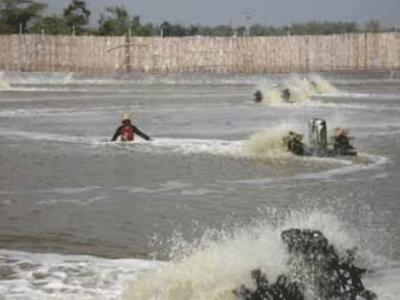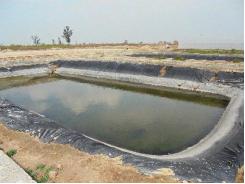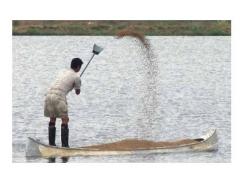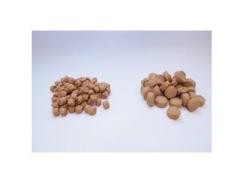Successful production in semi-biofloc in Indonesia

The Aquaculture Experience Farm in Java operated a hybrid system, based on a careful balance between autotrophic and heterotrophic organisms which gave average outputs of 20 tonnes/ha in early 2013.
High water exchange is standard practice to maintain suitable water quality in intensive shrimp production systems. However, environmental and biosecurity issues led farmers to develop methods relying on reduced or zero water exchange. A method that is commonly found in Thailand relies on recirculation systems where incoming water is treated in a reservoir before being pumped into rearing ponds, and where the pond effluent is directed towards a settling pond and treated before being either discharged to the environment or re-used for the next pond stocking.
Another example is the Biofloc Technology (BFT) system that was developed to reduce the risk of pathogen entry, minimise effluent discharge and protect the surrounding environment. For further information on BFT, please refer to publications in trade magazines and scientific journals, including those of Dr Yoram Avnimelech and Dr Ngan Taw.
The concept was applied in Indonesia, first at PT Central Pertiwi Bahari, then at other farms in Medan, Java and Bali. The success of these systems relies on high stocking density, adequate aeration, as well as the right amount and form of carbon/nitrogen ratio fed to the system. The understanding of the basic concept, the right tools to monitor the system and the right infrastructure will explain the success or failure of the technology under commercial conditions.
Despite the interest of many Indonesian shrimp farmers in the technology, the failure of various projects due to unsuitable facilities (no back-up in the case of power failure and limited monitoring), or incorrect number and position of the paddlewheel aerators, led farmers to move away from BFT. Many Indonesian farms (around 50%, personal communication Cindomas) switched to the semi-biofloc system (i.e. the hybrid system), using a rearing protocol adapted to local characteristics, facilities and infrastructure. The purpose of this article is to describe the semi-biofloc or hybrid system, as applied in farms in East Java.
The hybrid system
The hybrid system, as operated in many Indonesian farms, is based on a careful balance between autotrophic and heterotrophic organisms. These organisms create what we call bio-microfloc which is a smooth and compact aggregate matter made of green algae (mostly chlorella) and bacteria (mostly Bacillus supplied via commercial probiotic), as well as detritus, organic particles and protozoa. The organisms from the bio-microfloc control water quality by converting uneaten feed, dead plankton and shrimp faeces into compounds that are non- toxic.
This action of the biofloc organisms not only detoxifies the system but also improves the stability of the rearing environment. As a consequence, the bio-microfloc can be called ‘bio-conditioner’. The bio-microflocs are also a natural source of food for shrimp. For further information on the composition of the biofloc, and also the impact of probiotics on the nutritional value of the biofloc, we refer to publications, among others, from The Oceanic Institute (USA), Texas A&M (USA), Waddell Mariculture Center (USA), and the Fundação Universidade Federal do Rio Grande (Brazil).
Contrary to the full BFT, the balance between phytoplankton and bacteria is of the order of 30-40% autotrophs and 60-70% heterotrophs. With the development of the bio-microfloc, the pond water colour can be described as light brown or cream. The volume of bio-microfloc in the pond water has to be managed through the addition of chemicals (calcium carbonate, magnesium carbonate), organic matter, and microbial products (Sanolife PRO-W) or limited water exchange.
The shrimp pond is prepared for 20 days and stabilised (with algae and bacteria) before stocking the post larvae (PL10). Key parameters are water colour, pH, alkalinity, and the composition of plankton and bacteria. As with BFT, aeration is very important. Paddlewheels must be positioned correctly in order to maximize oxygenation (above 4 ppm, for shrimp and the organic degradation of organic matter), improve water circulation and mixing (to avoid stratification) while directing the sludge towards the central area of the pond. (Photo 1)
Photo 1. View of pond with paddlewheel aerators
Problems with aerators can affect the suspension of biofloc, thus leading to the accumulation of biofloc biomass, the creation of anoxic zones and the dramatic reduction in dissolved oxygen. Power failures over an hour in duration can be critical. Back-up power generators must be available. Contrary to the zero-water exchange heterotrophic system, siphoning is routinely performed to control the organic matter (especially excess nitrogen), as well as the checking for the presence of dead shrimp. Water transparency is maintained at a Secchi disk reading of 25-30 cm. Limited water exchange is carried out if required.
Example from a farm in Indonesia
The farm, Aquaculture Experience, is located in Kabupaten Lamongan, East Java. It includes 40 ponds, of an average size of 3,000 m2 . Ponds are fully lined with HDPE. The total area of the farm is 27 ha.
Preparation for 20 days prior to stocking
After preparing the reservoir and pond, including setting up the biosecurity measures, i.e. crab protection and bird nets, the important phase of water preparation starts. This is the disinfection of the water using Sanocare PUR 1.2 ppm, followed by the initial enrichment of the rearing environment with the right nutrients. These include dolomite (10 ppm), a source of calcium carbonate and magnesium carbonate (Kaptan 3 ppm) and Bacillus mixture (Sanolife PRO-W 10 ppm). The small particles, together with the Bacillus mixture, are in fact a ‘floc starter’. These products are applied on a regular basis over a period of 2 weeks or so until the pond water is stable with the right balance of microorganisms. This is followed by the ‘directing phase’ where a more stable environment is obtained (Figure 1).
Culture operations
After stocking animals (PL10), the pond management consists of maintaining a stable environment through (1) strengthening the system and (2) controlling the system. The composition of the algal community is controlled through the manipulation of the N: P (nitrogen: phosphorus) ratio following Redfield stoichiometry, with targets of N: P ratio of 25: 1 (20-25 ppm nitrate and 0.5-1 ppm phosphate). Frequent addition of a source of nitrate (Sanolife Nutrilake 5 ppm) is required. In order to maintain the right equilibrium between algae and bacteria, the right mixture of Bacillus is frequently applied (Sanolife PRO-W 10 ppm). In order to compensate for mineral deficiencies, additives are mixed with the feed (protein content of 30-35%). Molasses is added 2 or 3 times per week at a dose of 10-15 kg/ha.
A combination of Sanolife PRO-W, dolomite and Kaptan 5 ppm is applied to establish and maintain aggregate (microfloc), with a target of 2-3 mL/L volume in Imhoff cones within 1.5-2 hours. This is different from the BFT system where the biofloc volume is generally higher, up to 15 mL/L. In order to maintain the stability of the system, water exchange is kept at a minimum. In addition to water quality management, feeding and shrimp health management, the mixed biofloc system also requires specific attention.and management. This includes the use of a central drain and siphon to remove the excess organic matter that would accumulate in the central area of the pond (following the right positioning of the paddle wheel). An additional benefit of the frequent siphoning is the evaluation of the shrimp moult and the observation of dead shrimp that would have accumulated in the central area (Photo 2).
Figure 1. Overview of the various phases in the hybrid system, as operated at the Aquaculture Experience farm.

Photo 2. After siphoning, workers check for dead shrimp or any indication of problems in the pond.

Two additional steps are taken. The immune system of the shrimp is optimised through the regular coating with a mixture of immunostimulants and nutraceuticals (Sano TOP-S). The feed conversion rate is improved through the coating of probiotics (Sanolife PRO-2).
Performance of recent crops
Tables 1 and 2 give the results of the last two culture cycles in late 2012 and early 2013 respectively. The operation at the farm with the hybrid system has led to the stable production of shrimp. The stocking density is only an estimation as there is a tendency for hatcheries to supply a higher number of PLs to the farm. Fine-tuning of the protocol to the conditions prevailing in this part of East Java led to an improvement of the feed conversion ratio (FCR) with an increase in the productivity.
Table 1. Harvest data from Aquaculture Experience farm operated under semi-biofloc in autumn 2012.

Table 2. Harvest data from Aquaculture Experience, farm operated under semi-biofloc in January 2013.

The phytoplankton was dominated by green algae with blue-green algae kept below 10% of the total community most of the time. Water transparency was reduced from 40-60 cm in the first weeks of the crop to 20-30 cm in the last 2 months of the crop (Figure 2).
Conclusions
As with other intensive shrimp rearing systems, it is important to have a well defined check list for each stage of cultivation, detailing the potential hazards at each stage, the precautionary measures, the parameters to be followed, and also the contingency plan. For each problem, an action plan (a solution) should be defined in advance. Looking at the ‘Early Warning System’, based on daily observation, we include parameters such as discolouration of the shrimp, changes in body shape and behaviour, extreme size variation, status of shrimp hepatopancreas and faeces, and slower growth rate.
Figure 2. Characteristics of the phytoplankton: water transparency (Secchi disc reading, cm), percentage of green algae and blue green algae in the total phytoplankton.

The important points to consider are
- Production must be biologically feasible, but also technically and economically viable.
- Production should be right from the first time. Avoid the mistake at the beginning.
- Prevention and control of disease through:
a. Reduction and control of stressful factors. System must be as stable as possible.
b. Stimulation and activation of the immune system continuously. This is achieved through the coating of a mixture of immunostimulants and nutraceuticals.
c. Control of pathogens, such as Vibrio, virus and fungi.
d. Identification of appropriate treatment in case of disease.
e. Containment of disease.
f. Optimization of the feed digestibility and absorption. This is achieved through the coating of Bacillus probiotics.
---
Author/s
Olivier Decamp
He received his Ph.D. in Zoology from The Natural History Museum, London, and the University of Leicester (UK) in 1996, with focus on wastewater microbiology. After spending 4 years in Japan, as a Postdoctoral Scientist in marine microbiology, he joined the aquaculture nutrition team at the Oceanic Institute in Hawaii, where he carried out work on microbial dynamics in zero exchange shrimp systems. In 2002, Decamp joined INVE Aquaculture, as an R&D scientist, where he was responsible for research and product development in aquaculture health. Since 2008, he is based in Bangkok and works as Pro
Related news
Tools

Phối trộn thức ăn chăn nuôi

Pha dung dịch thủy canh

Định mức cho tôm ăn

Phối trộn phân bón NPK

Xác định tỷ lệ tôm sống

Chuyển đổi đơn vị phân bón

Xác định công suất sục khí

Chuyển đổi đơn vị tôm

Tính diện tích nhà kính

Tính thể tích ao




 Probiotics reduce mortality and pathology in a standardised…
Probiotics reduce mortality and pathology in a standardised…  Low cost Medium Shear Extruder for pet food…
Low cost Medium Shear Extruder for pet food…